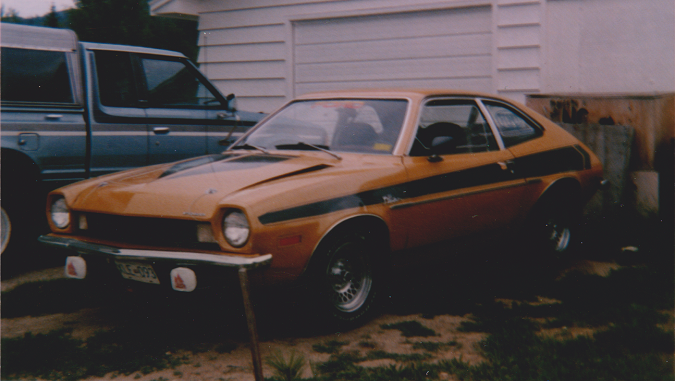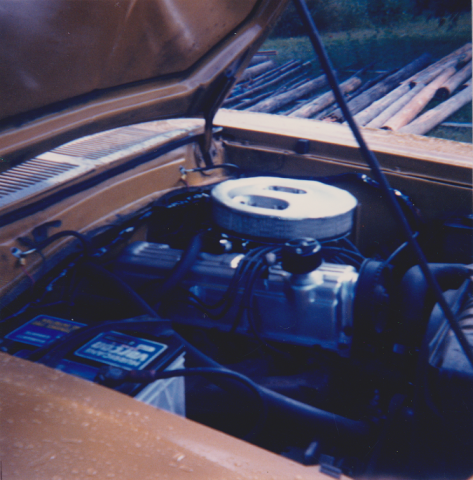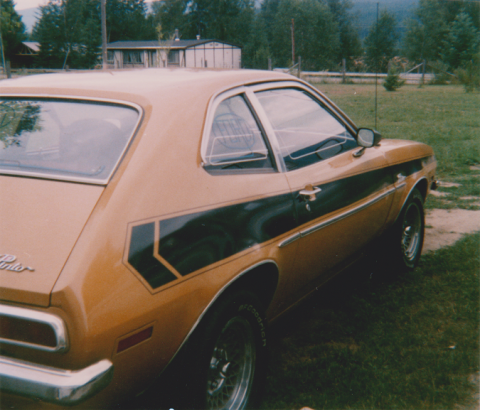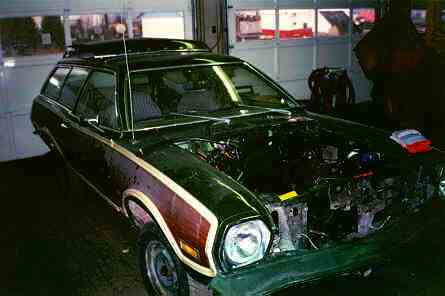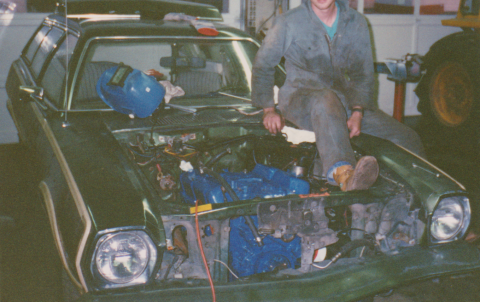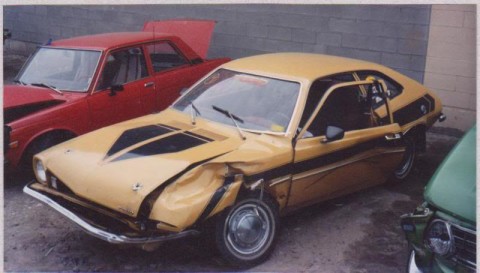’72 Pinto Sedan – the precursor
In highschool, I had a 1972 Ford Pinto. Most of my buddies who had muscle cars made fun of me, saying I should have gotten a Mustang or something. In college, they couldn’t afford to feed their cars.
I’m not going to jump up and down and say Pintos are cool. They aren’t. They are uncomfortable, don’t handle very well, break down frequently, rust, and blow up.
They also weigh 2000 pounds, and can fit a 302 V8.
Anyone can hop up a Mustang or Camaro or Nova, but it does take a bit of talent to slip a V8 into a Pinto, and the end result will be faster. More talent is required to keep it shiny side up and out of the ditch.
My philosophy behind this is basic Physics, where F = ma. For a more detailed discussion in this matter, please check out my page on acceleration.
My first experience with the Pintos was when I bought my first car at age 13. I bought a ’72 Pinto Sedan which came from Florida. It had no rust, no dents, no undercoating and no interior. To top it off the engine was dying. It had a 2.0L and 4-speed, 3.55:1 gears and bias ply tires. With P215/60R13 BFG T/As, it could accelerate as quickly as my friend’s ’73 318 Duster (which isn’t saying much about his duster, is it!?). I rationalized myself into getting another 2.0L as it would be the cheapest and most realistic solution. In retrospect I should have put a V8 in it. In fact, My father had picked up an old F-150 for parts that someone had started installing a 351 Cleveland. That would have been nice, but heavy.
I owned the Pinto for about three years, and in the first year of driving it, it required constant maintenance and repairs. Things broke on that car that should never break. Driving it was always and adventure – you never knew if you would even get there! I began to hate the car, and owning that pig was what drove me to buy Hondas. I needed reliability.
I sold it when I was 17 to another kid who totaled it within a month, and I swore I would never waste my time with another stupid Pinto as long as I lived.
So I bought another Pinto.
’74 Pinto Sedan – the cursor
A ’74 Pinto Sedan, into which someone had already put a 302 with milled heads and an FMX transmission. The Pinto originally came with a 2.0L, and the owner had relocated the 2.0L frame mounts and used truck 302 motor mounts. The transmission crossmember was a piece of angle iron bolted to the floor. It was pretty rough, with the stock rear end and lots of Bondo (from ending up in the ditch so often). It was painted “Midnight Brandywine,” but looked burgundy to me.
I bought it from a guy in Kelowna, with the intention of putting in a bigger V8. I was putting together a 351 Windsor to 1969 specs. I had wanted to adapt Cleveland heads, because at that time aftermarket heads were not very common, nor affordable, and Cleveland heads were HUGE (Think “Boss 351”). Since the work to do such a swap was intimidating, I stuck to my Windsor heads.
The heads were D0OE castings, and I ground the AIR bump out of the exhaust ports. I bought all new Manley valves, 1.84 intake, 1.50 exhaust (factory sizes). The camshaft was a Crane Hi Intensity 270° Hydraulic, 2000-6000 rpm. I used flat-top pistons, bored .040, honed to fit each piston, and the stock crank was turned .010/.010 under. I installed all new valve guides, put in Stellite valve seats for unleaded gas, installed heat treated keepers, Milodon 300lb. valve springs, and Chrome-Moly retainers. I also bought a factory ’69 four-barrel manifold with a brand new carburetor from a farmer who thought his 351 was a 302, and couldn’t get the manifold to fit the new motor (cheap price!).
Basically, I spent $1400 on a motor I never used, that I could have bought for $1100 with a warranty.
I say I never used it, because in measuring the Pinto engine bay, a 351W would be a huge squeeze. There IS NOT enough room (*) unless you bought hideously expensive headers. At that time, with my budget, and it still being a Pinto, headers were out of the question. Headers for a V8 Pinto exit the heads, and go FORWARD, then down in front of the front cross-member, as there is not enough room between the engine and the frame. I also drove the Pinto with the 302, and decided I would kill myself with a 351 in it. I sold everything and swore to never buy another Pinto again.
So I bought another Pinto.
’76 Pinto Wagon – the expletive
It was a ’76 Pinto Wagon with a 2.3L/C3 automatic. Bought it for a flat of beer – it ran, but before I could drop a brick on the gas pedal and wait for it to blow, it stalled, and I never got it started again.
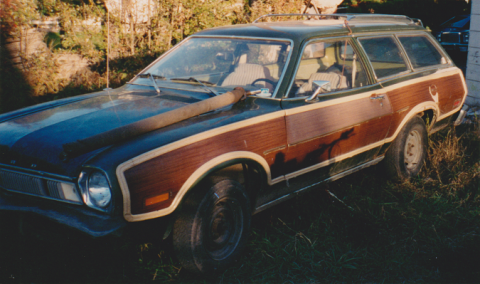
Freshly towed home – the car cost a flat of beer. Probably over-priced.
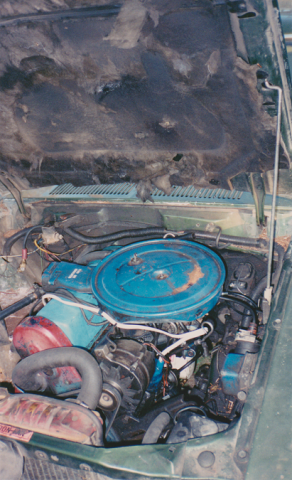
The little engine that couldn’t.
I also bought two 302 blocks, plus a rad, ignition, a 9″ differential, a couple of manifolds, and a whole bunch of odds and ends from a buddy who was parting out a ’77 Ford Granada. These are GREAT parts cars for this kind of swap. You get all the goodies, plus the narrowest 9″ that Ford makes, which bolts straight into the Pinto leaf springs. I also picked up a ’71 Ford F-150 for free, just to haul it away. I took the transmission out of it, since it was a C4. The wagon came with an old C4 in the back, and I mixed the two to get a Truck C4 that would work in a car.
I saw how the last guys swapped the 302/FMX, and here’s what I did, with what I would do differently:
Engine
The first thing I did was to put together an engine. I had three complete motors. I used the Granada short block, because the ’77 302s use open chamber heads, and flat top pistons. I used heads from the ’71 Truck, because they were closed chamber, and they did not have an AIR bump in them. The effective compression ratio was about 10:1. One of the three engines had a Crower Monarch 280° cam in relatively good shape. I was in college, I was on the cheap, I re-used it. I also picked up a ’68 factory four-barrel manifold.
I did not cut the oil pan. My MIG skills were lacking a bit at the time, I couldn’t MIG a water-tight seal. So instead, I adapted the Granada engine mounts to the 2.3L rubber mounts. This required drilling one hole to line up correctly. I also found a few cracks on the motor mounts, which I tried to weld but couldn’t close the crack. To be safe, I chained the motor down. Chain always says “Performance.” (Grin)
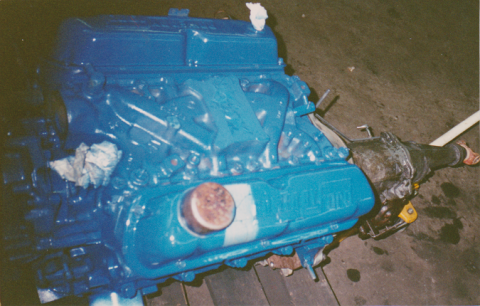
302, flat top pistons, small chamber heads (from a 260? 221?) , Crower Monarch 280° camshaft

Should have used the right oil pan, but holes in the hood are cool!
The proper way to use this, is of course to use factory components. You may discover that they are hard to come by. However, for your interest, here is some information clipped from Hot Rod Magazine, May 1988:
| “The ’74-’80 Pinto is a close relative to the Mustang II, so the stock parts used to install a V8 in the latter car will work. Required are V8 Mustang II Motor insulators, brackets, oil pan, oil pump pickup, and accessory mounting brackets.First position the engine, then drill the required mounting holes. Nevertheless, it’s still a tight fit. The typical protruding lip at the firewall-to-floorpan intersection point may need to be laid back or trimmed.
Finally, OEM Mustang II V8s used a special reduced-diameter C4 torque converter housing, with corresponding downsized 148-tooth flexplate, block plate, dust cover, and torque converter; these can still be installed on “normal” C4s if the existing housing still hits. Manual trannies used behind Mustang V8s were weak downsized boxes not suited to performance use. If you’re installing a heavy duty manual trans or C6 automatic, the firewall and floorpan require modification. |
|
The Granada motor mounts and 2.3L insulator mounts set the motor high enough that the oil pan would clear the front crossmember, but the front sway bar had to be relocated slightly lower. The upper right side of the transmission tunnel had to be clearanced with a Fairly Big Hammer (FBH), as the Truck C4 bellhousing is quite a bit larger than the Pinto’s C3. Raising the engine also reduced the amount of room for the cooling fan. The V8 fan would hit the hood, so I used the 2.3L fan, which is smaller in diameter. This causes problems which I will explain later on.
The engine also sat far enough forward that you could actually reach the engine-to-tranny bolts (a feat in itself), but that left little room for a radiator. The rad support was torched, and a new one fabricated using 2″ angle iron to hold the Granada cross-flow radiator. The radiator was mounted about 1/8″ away from the fan. Then the hood support structure contacted the new radiator, so the underside of the hood was skinned to provide room. The hood latch was consequently removed, and so hood pins should have been installed, but I was on the cheap, and used a length of chain, to bolt the engine hood to the bumper (on the backside so it couldn’t be seen).
Now, the radiator was mounted lower than the engine in order to clear the hood (Bobcat hoods are raised at the front, which would give lots more room, but I think they look stupid), so I installed a rad flush fitting to one of the heater hoses, so the system could be bled of air, and filled with water. A coolant overflow tank was fitted, using an old oil container.
V8 Pintos, along with most neat engine swaps, have a nasty habit of overheating. The reason is simple, the solution is not. If you put a big huge engine into a teeny tiny engine bay, the open area that used to let the hot air out is now filled with engine. The hot air can not escape, and cool air can not flow past the radiator. Add high compression and a lumpy cam, and the engine will naturally overheat anyway. The solution is to cut the inner fenderwells out, allowing the hot air to escape out the wheelwells. Do not cut the cowl, thinking that the hot air will flow out over the windshield. The cowl is a high pressure area, and when the vehicle is in motion, this high pressure will work against the flow of air through the rad. The end result is little if not worse cooling.
The 2.3L ignition module worked on the V8, but had to be moved to the passenger side of the vehicle, as the distributor was now in a different place. The alternator was also on the opposite side, so the regulator had to be moved.
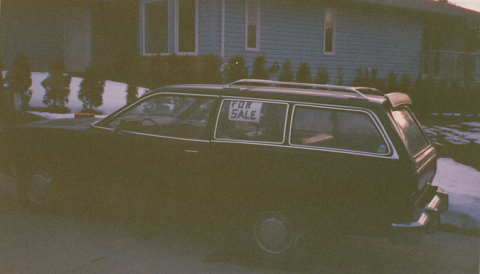
As always, not enough pictures, and those that were taken, were taken poorly. Didn’t keep the car long, but boy do I still miss it!
Transmission
The transmission was built from two different transmissions – a Truck V8 C4, and a Car 4 cyl. C4. The Truck C4 is a physically stronger transmission, with a reinforced case, among other things. The Truck, unfortunately, uses a driveshaft yoke that bolts directly to the tailshaft, as the truck’s driveshaft changes it’s length with respect to suspension movement through a splined connection at the steady bearing.
To make this work, you must disassemble the transmission, and remove the tailshaft. The Car tailshaft fits perfectly. Even though it was from a 4 cyl, it was the same physical size, and I assume strength. The car tailhousing fits as well, however the Truck’s vent is on the tailhousing, whereas the Car’s vent is on the case. This combination results in NO vent, and you’ll never get fluid into the transmission. As the tranny warms up, the fluid will be blown out the dipstick tube and all over the hot manifold. Not fun – trust me. The answer is to drill a hole in the top of the tailhousing, and pop in the vent from the truck housing.
I installed a Trans Scat II Stage 2 shift kit. The kit was very thorough, and easy to follow. The results were awesome! Very firm, very tight shifts.
I also had to fabricate my own shift linkage. The truck column shift linkage works sort of reversed to the floor mounted Pinto shifter. I had to make my own brackets, and align them to fit based on the movement of the floor shifter and the movement of the valvebody. It took a bit of time, but 1st was in 1st and park was in park and neutral was just right. The FMX Pinto I had didn’t shift into Low. The valve body didn’t match what the shifter was doing. Also, because of the tight engine compartment in the wagon, I did not have a kick-down linkage. This is generally a good thing to have, especially when passing. Had I kept the car, I probably would have fabricated one. As it was, I just downshifted when I wanted to (I preferred standard transmissions anyways).
The transmission crossmember worked in the original location, however I had to space the rubber mount farther forward (remember the engine location).
Exhaust
The passenger side manifold may have to be ground to clear the frame. I ground the heat tube off, and also torched the inner fender for clearance. You must use a driver’s side exhaust manifold from an early Mustang 302/289, or Mustang II, or Maverick. The pipe MUST exit straight out he back. In the 80’s Ford ran the pipe slightly down – this points at the steering. Late Mustang manifolds/headers don’t work. Some wreckers know that these manifolds are desirable, and I’ve had some quote me $125 CDN for one. ONE. I lucked out and found one for $20. I have another in my garage in case I build another Pinto. I figure if I hang onto it, I won’t buy another Pinto, but once I get rid of all the parts, I’ll build one again…
I bent up 2″ dual exhaust for the car. Snaking the pipes up to the engine was difficult – there’s not much room. Tailpipes are difficult, as you’d have to run both pipes around the diff, and out the passenger side rear of the car (the gas tank is in the way). I just dumped the exhaust in front of the rear end, and drove with the window open. I was also using turbo style mufflers because they don’t “drone” on the highway. Since they will only fit just before the rear end, there is little room for tailpipes. Glasspacks would be easier to hug into the transmission tunnel, and then exit in front of the rear wheels, on either side. This would also flow well, because they are shorter length and less bends than full exhaust to the back. Noisier, though.
Headers are nasty expensive. Ideal, but I’ve got better things to sink my money into, and besides, with a strong 302 in a Pinto, headers are just lipstick on a pig. If you are serious, Hooker Headers part #6161 fits ’74-’80 Pintos and cost $280 in 1984. I just can’t justify spending more on headers than the initial purchase price of the the car and all the parts. Besides, do you really need headers?
Other
Oddly enough, the driveshaft fit with no modification at all. I ran the stock differential with the intention of swapping it for the Granada 9″ when the Pinto diff blew. My philosophy is “If you don’t break traction, you’ll break something else.” The Pinto never hooked up, so I never blew the rearend. The Granada has the narrowest 9″ differential Ford makes. Granadas later than ’77 don’t use a 9″, so be wary. The Lincoln Versailles is based on the Granada, but their differential has disc brakes – a nice touch, but $1000 used. The 9″ will totally bolt into the Pinto, but the shocks mount differently – unless you can find the diff mounts that share the same shock mount as the Pinto.
Power steering was easy to adapt. I used the brackets and pump from the Granada, and used a flare fitting adaptor to fasten the Pinto power steering to the Granada pump.
Recommendations
Use Mustang II components: The oil pan, the manifolds, the radiator, etc. This will set the engine as far back and as low as possible. There is an awful lot of weight on the front end – setting the engine back will improve the balance somewhat.
Use Mustang II front springs. Dropping in a 302 lowers the front end close to 2″ – the balance is also greatly upset, and the car will constantly oversteer (hello ditch!). The Mustang II is much stiffer, and those springs in a Pinto are quite nice. Do not remove the Pinto sway bar. The bar will help control oversteer.
The wagon is a little more controllable, plus there is more weight on the rear end.
Traction is a continual problem. Rain sucks. Snow is downright scary. I usually started off in second just to avoid wheel spin, and that brutal 1-2 shift. Getting nasty on the gas pedal is an invitation to see the mean side of a pole or ditch. First gear would just blaze the tires. Second gear would go snaky. I’d chicken out before third. On the upside, it was very quick, and 135mph was attainable. Mind you, you were taking up two lanes to do it.
I didn’t have any structural problems, but it would probably be only a matter of time. Sub-frame connectors are a good idea. Again, “if you don’t break traction, you’ll break something else.”
10:1 compression is pretty high. The cam was big enough to bleed off some cylinder pressure, but on the highway the car would detonate constantly. It took some messing around to get the perfect blend of idle speed and initial timing so that the car could idle in gear without stalling (a higher stall speed converter would fix the creep at idle), yet cruise without detonating (re-curve the distributor). I disconnected the vacuum advance, as at cruise, the advance was too much. I also got about 5mpg.
Conclusion
The V8 Pinto is a cheap thrill. It’s fun. It’s a challenge. It hauls. It’s not something I would drive every day, but it’s a hoot to drive. I’d probably build another one, but my preference would be for 71-73, as they are the lightest, simplest of the Pintos. And probably another wagon because they just look cool (and unsuspecting).
Footnote: (?) Before you add yourself to the vast number who email me to criticize me about this statement, please understand that I am NOT saying the 351 cannot fit in the Pinto. It can. Crikey, a 460 can fit, given enough time and effort. It just wasn’t worth it for me at the time. If you feel SO compelled to criticize, please understand that I don’t care. Surely there is something better you could be doing with your time?
Interesting story: A while back, someone had listed a picture of my yellow Pinto on Craigslist or some such thing, trying to sell it for ~thousands~ of dollars. Rest assured, it was not me. The car did not last even a year after I sold it way back in 1989

